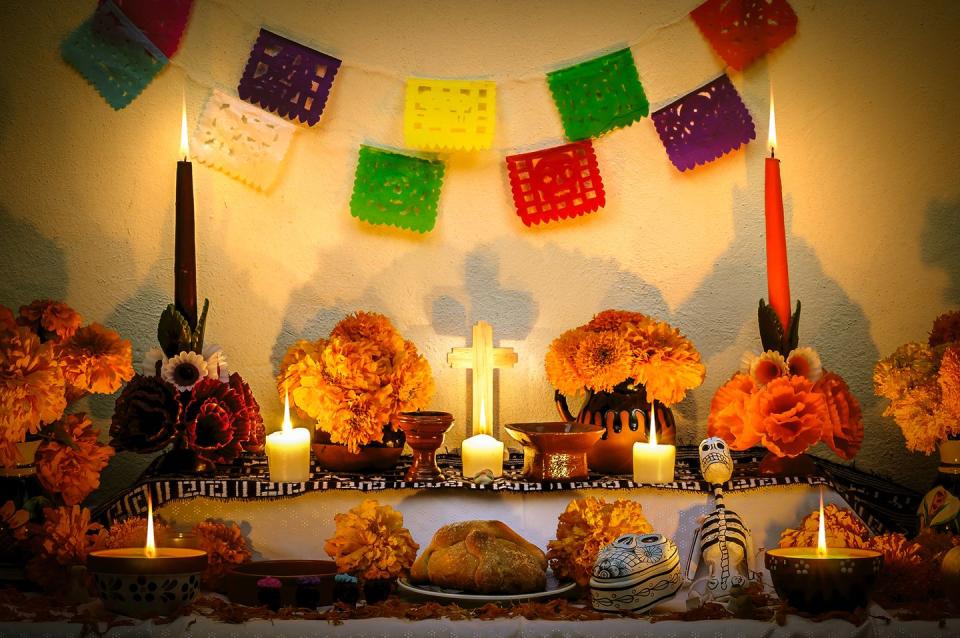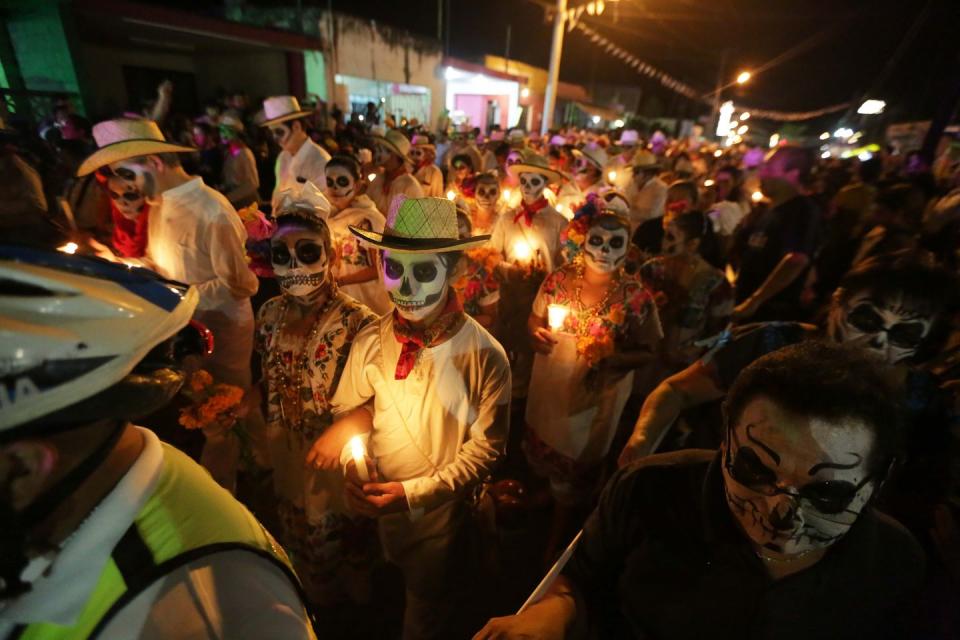You Should Learn About These Día de los Muertos Traditions Before Celebrating It
In the U.S., death is mostly associated with morbidity, grief, and a deep sense of loss. It's not something people discuss very openly, and Americans rarely like to even acknowledge it. But in Mexican and Latinx culture, it's a part of life, worthy of acknowledgment and woven into daily life. Loved ones who have died are honored, celebrated, and continue to be a part of the lives of the families they left behind. There is mourning, yes, but there is also celebration with parties and humor, culminating in their annual Día de los Muertos traditions.
Día de los Muertos, or Day of the Dead, is a popular holiday that originated in Mexico and has spread across Latin America since its inception thousands of years ago. Families visiting local cemeteries on November 1 and 2 to pay homage to those who have passed is just one of the many Día de los Muertos traditions people throughout Mexico and Latin countries carry out every year.
Before diving into all of the incredible traditions that come with the holiday, it's important to note that while Día de los Muertos and Halloween fall back-to-back and may seem to have some similarities on the surface, they are very different and should not be compared. It can be easy to accidentally (or even intentionally) culturally appropriate Día de los Muertos due to its rich heritage, stunning makeup, and gorgeous costumes. But there's a difference between cultural appropriation and appreciation, and that difference hinders mostly on a person's intentions and their level of understanding when it comes to Día de los Muertos. So to ensure that you're thoughtfully appreciating this important holiday, instead of appropriating it, here's everything you need to know about Día de los Muertos, its origins, and its traditions.

What is Día de los Muertos?
Día de los Muertos is a combination of indigenous Aztec rituals and Catholic traditions, the latter of which were brought over to what is now Central Mexico from Spanish colonizers. According to National Geographic, the Aztec and other Nahua people believed it was disrespectful to mourn the dead because death is a natural part of life. They believed that when a person died, he or she traveled to Chicunamictlán, the Land of the Dead, and had to overcome nine challenging levels of the afterlife before reaching their final resting place, Mictlán, according to The History Channel. To honor the dead and help their lost loved ones complete their grueling journey, the Nahua people provided the souls with food, water, and tools, which plays a large part in how people celebrate Día de los Muertos today.
What is now known as the Day of the Dead used to be a month-long holiday that took place at the end of the summer. When Spanish colonizers landed in Mexico in the early 16th Century, however, they felt the holiday was sacrilegious, according to NBC. Over time, the celebration evolved and eventually meshed with the Catholic holidays, All Saints' Day and All Souls' Day, which take place in the fall.
When and how is Día de los Muertos traditionally celebrated?
From midnight on November 1 to 11:59 p.m. on November 2, those who celebrate Día de los Muertos believe or pay homage to the belief that the border between the spirit world and the real world dissolves, allowing for the souls of people who have died to return and visit their families, The History Channel noted. In order to welcome their relatives' souls back to the world of the living for the night, those who celebrate the holiday construct ofrendas, also known as offerings or altars, in their homes and local cemeteries. The altars are covered with a number of offerings for loved ones lost — sugar skulls, pan de muerto (bread of the dead), and toys for children who have died. These offerings are often accompanied by the dead's favorite foods and traditional drinks, like pulque (a sweet fermented drink made from agave), atole (a thin, warm porridge made from corn flour, with cane sugar, cinnamon, and vanilla), tequila, or hot chocolate.

On the altar, living family members place photos of and light a candle for each relative who has passed away, decorating the entire ofrenda with marigold pedals, colloquially referred to as the "flor de los muerto," or flowers of the dead. According to Nat Geo, the bright orange blooms are also scattered from the altar to the gravesite in hopes of guiding the wandering souls back to their resting places. Copal incense, made from tree resin, is also used to purify the area surrounding the altar.
What are the important symbols of Día de los Muertos?
Perhaps one of the most famous symbols of Día de los Muertos is a skull, often painted on the faces of people participating in the annual festivities, as well as its sugar counterparts that are placed on altars (the latter represents the sweetness of life, according to Smithsonian Magazine). But before skulls became one of the holiday's most well-known traditions, there were literary calaveras, also known as skulls. In the late 1700s, early 1800s, the word calavera described short, funny, and often sarcastic poems that made fun of the living, Nat Geo noted, which eventually became a Día de los Muertos tradition.
The skeleton face that has become widely associated with Day of the Dead celebrations actually came from a political cartoon drawn by José Guadalupe Posada in the early 1900s to accompany the literary calaveras, Nat Geo reported. Posada etched the skeleton and dressed it up in fancy French clothes to emulate high-society people in Mexico with Euro-centric ideals, also according to Nat Geo. "Todos somos calaveras," was a popular quote from the political cartoonist. "We are all skeletons."
Decades later, artist Diego Rivera took Posada's skeleton and featured it in his mural, Dream of Sunday Afternoon in Alameda Park. Rivera painted the original skeleton, dressed it in women's clothes, and named her Catrina, which was slang for "the rich." Voila, a Día de los Muertos icon was born.

How do people celebrate Día de los Muertos today?
Today, men, women, and children take to the streets at all hours of the day and night on November 1 and 2 to honor their deceased loved ones in full head-to-toe costumes for the numerous parades that take place across Mexico and other Latin countries. They paint their faces with skeletons, wear oversized hats, and don suits and fancy dresses to imitate the Calavera Catrina. Though Cartrina is now the country-wide symbol of death, and a pivotal part of Día de los Muertos celebrations, the skeleton was initially used as a way to poke fun at Mexican high-society, which makes sense, considering the holiday is in part about mocking death. The skeleton face paint and sugar skulls that decorate the altars and are eaten on the Day of the Dead show Death that people from Mexico and other Latin countries are not afraid of it, and will embrace it whenever it comes for them and those they love.
Up and down the streets during the parades, you can spot countless papel picados, or perforated paper, another Día de los Muertos tradition, though it's not exclusive to the holiday. Papel picado is colored tissue paper that is hammered and chiseled to make gorgeous decorations that add a little umph to altars and dress streets all over Mexico. According to Smithsonian Magazine, the holes in papel picado allow for spirits to travel through them and the delicate paper signifies the fragility of life.

Should you celebrate Día de los Muertos?
With all of the beautiful and endearing Día de los Muertos traditions, it can be tempting to want to recreate some of them in your own home. But before you start Googling "how to celebrate Día de los Muertos," it's important to think about a few things when it comes to cultural appropriation. Why do you want to celebrate Día de los Muertos? Is it because you think it would be way Instagrammable and secure you a lot of likes? If so, it may be best to refrain. That's not what this holiday is about.
But do you understand the origins and meaning of the holiday? Do you respect Mexican and Latinx culture in general? Are you supporting a friend and/or family member who is celebrating, or are you looking to get more in touch with your Mexican or Latinx roots? If so, then perhaps embracing the holiday this year is appropriate.
It all comes down to your intentions. If you want to share in this meaningful celebration of life and death because you're eager to learn about other cultures, broaden your perspectives, and connect with people different from you (or to connect with yourself), then by all means, adopt these Día de los Muertos traditions. Keep in mind, however, that even if you have the best of intentions, some who treasure these celebrations may still considered your celebration inappropriate. And if someone confronts you about it, listen to those for whom Día de los Muertos is a way of life. Learn from them, thank them for the education, then do better next time.
Want to make your holidays shine? You’re in luck! Subscribe to Woman's Day today and get 73% off your first 12 issues. And while you’re at it, sign up for our FREE newsletter for even more of the Woman's Day content you want.
You Might Also Like


